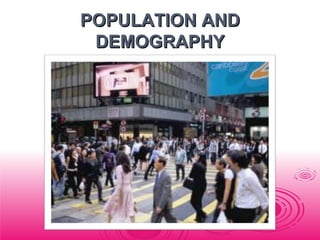
Chapter 16
- 2. After studying this chapter, you should be able to: Define the three major components of population change. Summarize Malthus’ theory of overpopulation. Summarize the demographic transition model and explain why there might be a second demographic transition. Describe the history of urbanization including a contrast of preindustrial and industrial cities.
- 3. DEMOGRAPHY The study of the size, rate of growth, and age composition of human populations, as well as the causes and consequences of changes in these factors. Demography is influenced by three major factors: fertility, mortality, and migration.
- 4. FERTILITY FERTILITY DEF: Fertility refers to the actual number of births in a given population. CRUDE BIRTHRATE The number of annual live births per 1,000 people in a given population. FECUNDITY The physiological ability to have children.
- 5. MORTALITY DEF: The frequency of deaths in a population. CRUDE DEATH RATE - the annual number of deaths per 1,000 people in a given population. INFANT MORTALITY RATE - Measures the number of children who die within the first year of life per 1,000 live births.
- 6. LIFE EXPECTANCY – DEF: The average number of years a person born in a particular year can expect to live. Highest Years Lowest Years Japan 82.0 Swaziland 31.9 Singapore 82 Angola 38.2 Hong Kong 81.8 Zambia 38.6 Australia 81.6 Lesotho 40.4 Canada 81.2 Zimbabwe 41 Sweden 81 Mozambique 41.1 France 81 Sierra Leone 41.2 Iceland 80.7 Liberia 42 Sweden 80.9 Djibouti 43.4 World 66.6 average
- 7. MIGRATION DEF: The movement of populations from one geographical area to another. EMIGRATION - When a population leaves an area IMMIGRATION - When a population enters an area.
- 8. INTERNAL MIGRATION The movement within a nation’s boundary lines—in contrast with immigration, in which boundary lines are crossed. RURAL TO URBAN This trend has slowed in industrialized countries AREAS OF ECONOMIC OPPORTUNITY Currently to Montana and South Dakota
- 10. MALTHUS POPULATION THEORY Populations will always grow faster than the available food supply LIMITS TO POPULATION GROWTH Preventive checks Include celibacy, the delay of marriage, and such practices as contraception within marriage, extramarital sexual relations, and prostitution
- 11. MALTHUS POPULATION THEORY LIMITS TO POPULATION GROWTH: - Positive checks Events that limit reproduction either by causing the deaths of individuals before they reach reproductive age or by causing the deaths of large numbers of people, thereby lowering the overall population.
- 12. DEMOGRAPHIC TRANSITION THEORY According to the demographic transition theory, societies pass through four stages of population change
- 13. DEMOGRAPHIC TRANSITION THEORY STAGE 1 – High fertility and high mortality. STAGE 2 - Mortality decreases, fertility stays high and population increases rapidly STAGE 3 - Birth rates begin to fall due to social, economic and religious changes STAGE 4 - Low fertility and low mortality.
- 14. DEPENDENCY RATIO The number of people of nonworking age in a society for every 100 people of working age. When birthrates decline below 2.1 per female (the replacement rate), the population can drop and fewer young people end up needing to take care of the old (the ration goes up)
- 15. SECOND DEMOGRAPHIC TRANSITION Some countries have moved beyond Stage 4 and are experiencing declining populations due to fertility levels well below replacement levels (2.1) The reason for this transition centers around a strong desire for individual advancement and improvement which either causes a delay in child bearing or a decision to forego children.
- 17. URBANIZATION Two requirements had to be met for the first cities to emerge (9000 years ago). The first was that there had to be a surplus of food and other necessities. The second requirement was that there had to be some form of social organization that went beyond the family. Did this already exist in the form of tribes? Did ruling classes develop due to excess production or was the new organization the cause of better production?
- 18. URBANIZATION Preindustrial cities - Cities established prior to the Industrial Revolution - Often were walled for protection - Densely packed with residents - Showed social stratification - Survived by controlling surrounding agricultural production. It required a favorable physical environment to allow for adequate excess production of food.
- 19. URBANIZATION Industrial Cities - Were established during or after the Industrial Revolution and are characterized by large populations that work primarily in industrial and service-related jobs. - Industrialization a number of affects on the city dwellers: 1. Food, clothing and shelter could be provided at a lower cost – raising life expectancy 2. A new class of social elites was created as well as a middle class of managers
- 20. RURAL VS URBAN LIFE Along with urbanization come certain changes from rural villages: - ANONYMITY - possible separation from family and lack of social status and support - CULTURAL HETEROGENEITY – exposure to many different sub-cultures SUBURBS- As transportation allowed, those with money moved away from the crowding, noise and perceived danger of the inner city.
Editor's Notes
- Stage 2 due to better health care, more food and better housing